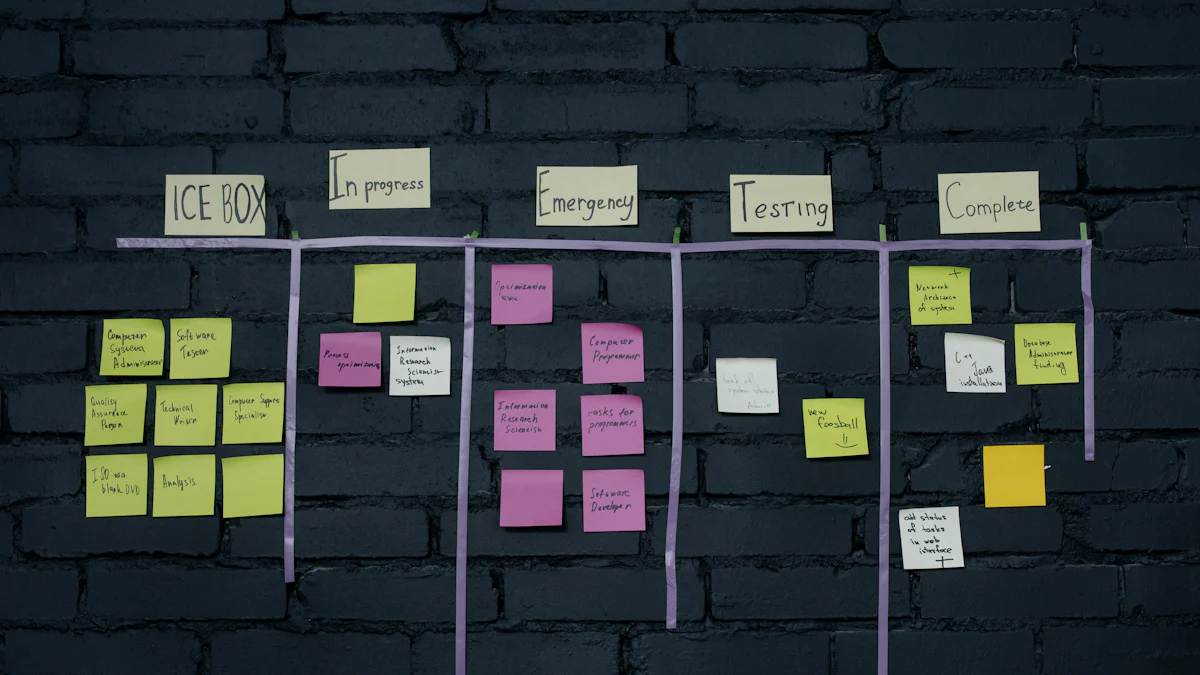Mastering Lean Agile Development Principles

In today’s fast-paced software industry, agile and lean development has become essential for delivering value efficiently. These principles help you eliminate waste, streamline workflows, and focus on what truly matters—customer satisfaction. Teams using Lean Agile practices report faster delivery, improved quality, and higher job satisfaction. By fostering continuous improvement and adapting to change, you can ensure your projects meet evolving customer needs. Lean Agile also prevents feature bloat and optimizes resources, enabling you to deliver just-in-time solutions that maximize impact while minimizing costs.
Key Takeaways
Lean Agile ideas remove waste and make work smoother, helping teams finish faster with better results.
Support your teams by encouraging teamwork and independence to boost work output and happiness.
Use feedback often to keep improving; get user opinions early to adjust your product well.
Add feature flags to manage new features, lower risks, and get quick feedback for smarter choices.
Try Agile methods like Scrum or Kanban to organize work and help teams work better together.
Understanding Agile and Lean Development
What is Agile and Lean Development?
Agile and lean development are two methodologies that help you deliver software efficiently while focusing on customer value. Agile emphasizes iterative progress, where teams work in small cycles to adapt quickly to changes. Lean, on the other hand, focuses on eliminating waste and optimizing processes to maximize efficiency. Both approaches share a commitment to continuous improvement and delivering high-quality products.
Aspect of Comparison | Agile | Lean |
|---|---|---|
Emphasizes continuous improvement. | Focuses on the elimination of waste. | |
Customer Value | Prioritizes customer value through continuous improvement. | Prioritizes customer value by emphasizing product quality. |
Methods for Fast Delivery | Works in short cycles for faster project completion. | Eliminates wasteful factors to speed up product delivery. |
Continuous Improvement | Seeks to improve by incorporating end-user feedback. | Aims to enhance by removing waste at every stage. |
End Goal | Produces a product that meets end-user or stakeholder needs. | Eliminates non-value-adding factors in product development. |
Agile and lean development complement each other. Agile focuses on adaptability and collaboration, while lean ensures efficiency by removing unnecessary steps. Together, they create a powerful framework for modern software development.
The Origins of Lean Agile Principles
The roots of lean principles trace back to the Toyota Production System, which aimed to reduce waste and improve manufacturing efficiency. Over time, these principles were adapted for software development to address inefficiencies in traditional methods. Agile principles emerged later, driven by the need for faster and more flexible software delivery.
Lean principles originated from the Toyota Production System, which aimed to reduce waste and improve efficiency in manufacturing. Agile emerged as a response to the slow and costly traditional software development methods, leading to the Agile Manifesto in 2001.
The rapid evolution of technology and the increasing demand for software solutions highlighted the limitations of older methodologies. Businesses needed a way to plan, develop, and release products faster while maintaining quality. This need gave rise to agile and lean development, which prioritize adaptability and efficiency.
Why Agile and Lean Development Matters Today
In today’s competitive software industry, agile and lean development help you overcome common challenges. Specialized hiring requirements, limited resources, and organizational changes can slow down projects. Agile and lean principles address these issues by promoting team autonomy, efficient resource management, and adaptability.
Modern software development also faces risks like delayed decision-making and difficulty measuring progress. Lean encourages you to defer decisions until the last responsible moment, ensuring better outcomes. Agile helps you track progress through iterative cycles and regular feedback. Together, these methodologies enable you to deliver value faster while maintaining high standards.
By adopting agile and lean development, you can respond to changing customer needs, reduce waste, and create products that truly add value. These principles remain essential for navigating the complexities of modern software projects.
Exploring the 7 Principles of Lean Software Development

Eliminating Waste
Identifying and Removing Non-Value-Adding Activities
Waste in software development often slows down progress and reduces efficiency. You can eliminate waste by identifying activities that do not add value to the final product. Common examples include:
Waiting: Delays caused by dependencies, such as waiting for approvals or code reviews.
Handoffs: Miscommunication and delays when work moves between teams.
Defects: Bugs that require rework, highlighting the importance of quality.
Overproduction: Building features that users do not immediately need.
Extra Processing: Redundant meetings or excessive documentation.
Task Switching: Reduced productivity when developers juggle multiple projects.
By addressing these inefficiencies, you can streamline workflows and focus on delivering value to your customers.
Streamlining Processes for Maximum Efficiency
Streamlining processes ensures that every step in your workflow contributes to the final product. You can achieve this by automating repetitive tasks, reducing unnecessary approvals, and fostering better communication between teams. For example, using tools like feature flags allows you to test features incrementally, reducing the risk of defects and enabling faster delivery. This approach aligns with the lean software development principle of eliminating waste.
Amplifying Learning
Encouraging Knowledge Sharing Across Teams
Knowledge sharing accelerates learning and improves team performance. You can encourage this by implementing practices like code reviews and pair programming. These activities allow team members to learn from each other’s expertise. Presenting technology to peers or engaging in deliberate practice sessions also enhances understanding. Structured coaching or facilitated workshops can further amplify learning within your team.
Using Feedback Loops to Drive Improvement
Feedback loops are essential for continuous improvement. By gathering user feedback early and often, you can identify areas for enhancement. Experimentation plays a key role here. For instance, releasing features to a subset of users helps you collect real-time data and refine your product. This iterative process ensures that your team learns quickly and adapts to user needs effectively.
Deciding Late
Preserving Options for Better Decision-Making
Delaying decisions until you have sufficient information leads to better outcomes. This approach allows you to stabilize requirements and make informed choices. For example, flexible architectural design enables you to postpone decisions until they are absolutely necessary. This reduces the risk of making premature choices that could negatively impact your project.
Adapting to Changing Requirements
In software development, requirements often evolve. By deciding late, you can adapt to these changes without disrupting your workflow. Agile methodologies support this by encouraging iterative development. Lean software development emphasizes basing decisions on facts rather than assumptions, ensuring that your team remains flexible and responsive to new information.
Delivering Fast
Shortening Development Cycles
Shorter development cycles allow you to respond quickly to customer needs. By breaking down large projects into smaller, manageable tasks, your team can focus on delivering value incrementally. This approach reduces the time between planning and release, ensuring faster feedback and adjustments. For example, Sipgate adopted Agile and Lean principles to improve product development speed, while ING streamlined processes using the PACE model to validate innovations with customers. These real-world examples highlight how shortening cycles can enhance efficiency and customer satisfaction.
Incremental Delivery for Faster Value
Incremental delivery ensures that your team delivers value to customers as early as possible. Instead of waiting for a complete product, you can release smaller, functional components. This method allows users to benefit from new features sooner while providing valuable feedback for future iterations. Feature flags can support this process by enabling controlled rollouts and real-time testing. Companies like Penta Technologies have successfully implemented Scrum to achieve faster delivery and empower their teams, demonstrating the effectiveness of incremental delivery in Lean Agile practices.
Empowering Teams
Promoting Collaboration and Autonomy
Empowering your team starts with fostering collaboration and autonomy. When team members work together and make decisions independently, they feel more invested in the project’s success. Trust plays a crucial role here. You can build trust by defining clear outcomes, enabling open communication, and celebrating achievements. For instance, Penta Technologies experienced a dramatic increase in productivity after empowering their teams through Agile practices. Encouraging shared responsibility and providing the necessary resources further strengthens team cohesion.
Building a Culture of Accountability
Accountability ensures that every team member takes ownership of their work. You can promote this by setting clear expectations and providing relevant feedback. Acknowledge successes and encourage continuous improvement to create a no-blame culture. Studies show that teams with shared experiences of past successes are more likely to excel in future projects. By holding teams accountable and celebrating their milestones, you can build a motivated and high-performing team.
Building Quality In
Embedding Quality Assurance Throughout Development
Quality assurance (QA) should be an integral part of your development process. Start by integrating QA from the beginning and maintaining it throughout the lifecycle. Practices like Continuous Integration (CI) and automated testing help identify issues early, reducing the cost of fixes later. Focus on the end-user experience to ensure your software is both functional and user-friendly. Collaborating closely with QA teams and developers ensures that quality remains a priority at every stage.
Shifting Left in Testing Practices
Shifting left means addressing potential issues earlier in the development process. By testing during the initial stages, you can catch defects before they escalate. This approach saves time and resources while improving overall quality. Automation plays a key role here, enabling faster and more consistent testing. Embracing a shift-left mindset aligns with Lean principles by embedding quality into every step of development, ensuring your product meets high standards from the start.
Optimizing the Whole
Aligning Teams Around Shared Goals
Aligning your teams around shared goals ensures that everyone works toward the same objectives. When teams lack alignment, confusion arises, and delays occur. To prevent this, you need to establish clear goals that resonate across all departments. These goals should focus on delivering customer value and fostering collaboration.
Investing in the right tools and platforms can also help you achieve alignment. Tools like project management software or feature flag platforms streamline communication and keep everyone on the same page. Without these tools, reaching milestones on time becomes challenging.
Invest in the Right Tools and Platforms: Don't skimp on your tech stack — you need to invest in the right software development tools and platforms. Without the right tools, you'll have a hard time reaching your milestones and goals on and ahead of time.
Leadership plays a critical role in this process. Leaders must communicate the vision clearly and provide the resources teams need to succeed. By fostering trust and psychological safety, you can encourage innovation and adaptability within your organization.
Enhancing Cross-Functional Collaboration
Cross-functional collaboration brings together diverse expertise to solve complex problems. To enhance collaboration, you should create an environment where teams from different functions work together seamlessly. Encourage open communication and shared accountability to break down silos.
The iterative process is a proven method for optimizing collaboration. By creating, testing, and releasing prototypes, your teams can gather feedback and refine their work. This cycle of continuous improvement ensures that every team contributes to the overall success.
The iterative process is an approach that software developers, scientists, and others use to continually improve products and design. Developers create, test, and release a prototype. After receiving customer feedback, they modify, test, and release a revised prototype. They will do this at regular intervals to continuously improve the product.
Challenges like inadequate resources or ineffective governance can hinder collaboration. Address these by providing clear guidelines and ensuring leadership support. When teams feel supported, they are more likely to embrace new practices and work cohesively toward shared goals.
Practical Applications of Lean Agile Principles
Implementing Lean Agile in Software Development
Adopting Agile Frameworks (e.g., Scrum, Kanban)
Agile frameworks like Scrum and Kanban provide structured approaches to implementing Lean Agile principles. Scrum organizes work into sprints, enabling agile teams to deliver value incrementally. Kanban focuses on visualizing workflows and limiting work in progress, which enhances productivity and reduces bottlenecks. Companies like Spotify have successfully adopted the "Spotify Model," which emphasizes collaboration and autonomy. This approach has allowed them to deliver features rapidly and adapt to market demands. Similarly, Intel implemented the Scaled Agile Framework (SAFe) to streamline processes and improve product quality, resulting in faster time-to-market.
Visualizing and Limiting Work in Progress (WIP)
Visualizing workflows helps you identify inefficiencies and optimize processes. Tools like Kanban boards allow you to track tasks and ensure that work progresses smoothly. Limiting WIP prevents teams from overloading themselves, which improves focus and productivity. For example, Boeing used Lean Agile practices to reduce development cycle times and enhance collaboration. By managing WIP effectively, you can maintain steady progress and deliver high-quality results.
Overcoming Challenges in Lean Agile Adoption
Addressing Resistance to Change
Resistance to change often arises when teams feel uncertain about new practices. Open communication and education can help address skepticism and fear of the unknown. Involve team members in the transition process to build trust and foster acceptance. Recognizing and celebrating small wins can also motivate teams to embrace the lean agile process. For instance, organizations like the U.S. Department of Defense have successfully overcome cultural resistance by promoting transparency and providing adequate training.
Managing Cross-Functional Teams Effectively
Cross-functional teams bring diverse expertise to the table but can face challenges like misaligned goals or communication gaps. To manage these teams effectively, establish clear objectives and encourage collaboration. Regular feedback sessions and synchronized planning cycles can help align efforts. Applying systems thinking ensures that all team activities contribute to the broader organizational goals. Companies like Boeing have demonstrated the value of cross-functional collaboration in achieving successful product launches.
Fostering a Lean Agile Mindset
Leadership’s Role in Driving Change
Leadership plays a critical role in fostering a Lean Agile mindset. Leaders must actively guide teams, eliminate delays, and create a culture of continuous improvement. By organizing teams around value and empowering them to make decisions, leaders can enhance agility and responsiveness. For example, leaders at Spotify motivated teams to adopt better working methods, which contributed to their rapid delivery of new features.
Training and Coaching Teams for Success
Training and coaching are essential for building agile capability. Start by aligning goals with clear communication to ensure everyone understands the purpose of the transformation. Provide hands-on training in agile methodology, such as Scrum or Kanban, to cultivate a culture of continuous delivery. Encourage teams to embrace rapid feedback and iterative learning cycles. Sustaining this transformation requires fostering a learning culture that prioritizes adaptation and improvement.
The Role of Feature Flags in Lean Software Development

What Are Feature Flags?
Feature flags are powerful tools that give you control over the visibility and functionality of features in your software. They allow you to manage feature rollouts without deploying new code. With feature flags, you can:
Hide, enable, or disable features during runtime.
Separate feature rollout from code deployment for independent control.
Conduct testing in production environments.
Target specific users for new feature access.
At their core, feature flags are conditional statements in your code. Each flag has a status—on or off—that you can manage externally. When the flag is on, the new feature runs. If it’s off, the system retains its old behavior. This flexibility makes feature flags essential for modern software development.
How Feature Flags Support Lean Agile Principles
Reducing Risk with Controlled Rollouts
Feature flags help you reduce risk by enabling controlled rollouts. You can expose new features to a limited audience in production, gather feedback, and identify issues before a full release. This approach ensures a smoother user experience. Progressive rollouts combined with feature flags also minimize downtime during infrastructure migrations. If a feature causes problems, you can instantly disable it using the flag’s kill switch.
Accelerating Feedback Through Real-Time Testing
Feature flags accelerate feedback by allowing you to test features with real users in production. This method provides better data and faster insights compared to traditional testing environments. By decoupling deployment from release, you can deploy code more frequently and safely. This process supports smaller, iterative updates, which align with Lean Agile principles.
Minimizing Waste by Validating Features Early
Feature flags let you validate features early in the development cycle. You can release features to a subset of users and assess their value before a full rollout. This approach prevents unnecessary investment in features that may not work, helping you focus on what truly adds value.
Enabling Continuous Improvement with Iterative Releases
Feature flags simplify iterative releases by allowing you to control feature rollouts independently from code deployments. You can gradually release features, reducing the risk of widespread issues. This flexibility supports trunk-based development, enabling faster iterations and experimentation. With feature flags, you can refine features continuously based on user feedback.
Why FeatBit is the Best Feature Flag Tool
Key Features of FeatBit
FeatBit offers a comprehensive suite of features designed to enhance your development process:
Real-time control over feature visibility.
Support for progressive rollouts and A/B testing.
Instant rollback capabilities with kill switches.
Integration with popular development tools for seamless workflows.
These features make FeatBit a reliable choice for managing feature flags effectively.
How FeatBit Aligns with Lean Agile Practices
FeatBit aligns closely with Lean Agile principles by helping you:
Eliminate waste through early feature validation.
Build quality into your development process with real-time testing.
Deliver value faster with progressive rollouts.
Empower your team by simplifying feature management.
By using FeatBit, you can optimize your workflows and achieve greater efficiency in your projects.
Feature flags are not just tools—they are enablers of Lean Agile success. FeatBit ensures you harness their full potential to deliver high-quality software efficiently.
The 7 principles of Lean software development provide a clear roadmap for delivering high-quality software efficiently. These principles emphasize eliminating waste, amplifying learning, and empowering teams to adapt to changing requirements. The table below summarizes their key takeaways:
Principle | Description |
|---|---|
Eliminate Waste | Focus on removing anything that does not add value to the product. |
Amplify Learning | Encourage knowledge retention and testing of new ideas to avoid costly mistakes. |
Decide as Late as Possible | Delay decisions to adapt to changing requirements based on feedback. |
Deliver as Fast as Possible | Aim to optimize value by reducing waste and ensuring timely delivery of quality products. |
Empower the Team | Foster open communication and self-management among team members. |
Build Integrity In | Ensure quality in software code by maintaining both perceived and conceptual integrity. |
Optimize the Whole | Focus on the overall system rather than individual components to maximize efficiency and value. |
Tools like feature flags play a vital role in achieving success with Lean Agile practices. They enable rapid iterations and real-world testing, allowing you to gather customer feedback and refine features quickly. By decoupling feature rollout from code deployment, feature flags enhance flexibility and minimize risks. Gradual releases to targeted users help you maximize value while maintaining quality.
Start applying these lean principles and tools today to deliver software that meets customer needs and drives continuous improvement. By embracing Lean Agile principles, you can create efficient workflows and deliver exceptional value.
FAQ
What is lean development, and why is it important?
Lean development focuses on eliminating waste and optimizing processes to deliver value efficiently. It helps you streamline workflows, reduce unnecessary steps, and focus on customer needs. This approach ensures faster delivery, better quality, and improved resource utilization.
How does DevOps relate to lean development?
DevOps complements lean development by fostering collaboration between development and operations teams. It emphasizes automation, continuous delivery, and shared responsibility. Together, DevOps and lean principles enable you to deliver software faster while maintaining high quality.
What role does continuous improvement play in lean development?
Continuous improvement drives lean development by encouraging teams to learn and adapt. It involves regularly assessing processes, gathering feedback, and making incremental changes. This approach helps you refine workflows, enhance efficiency, and meet evolving customer needs.
How can feature flags support DevOps practices?
Feature flags allow you to control feature rollouts independently from code deployment. They enable real-time testing, reduce risks, and support iterative releases. This flexibility aligns with DevOps practices by promoting faster delivery and continuous improvement.
Why are cross-functional teams essential in lean development?
Cross-functional teams bring diverse skills together to solve complex problems. They improve collaboration, reduce silos, and ensure alignment with shared goals. This approach enhances efficiency and helps you deliver value more effectively.
See Also
Creating an Effective Feature Flag System for 2025 Development
Understanding Feature Flag Development and Its Importance in 2025
The Essential Role of Feature Flags in 2025 Software Development

